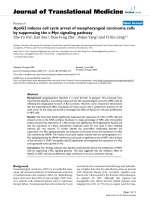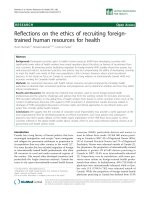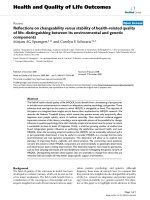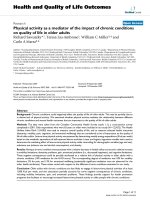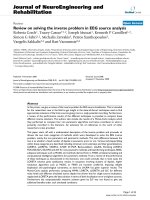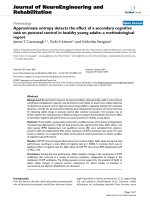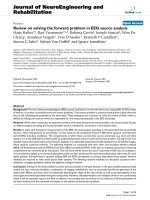báo cáo hóa học: " Reflections on changeability versus stability of health-related quality of life: distinguishing between its environmental and genetic components" potx
Bạn đang xem bản rút gọn của tài liệu. Xem và tải ngay bản đầy đủ của tài liệu tại đây (257.98 KB, 7 trang )
BioMed Central
Page 1 of 7
(page number not for citation purposes)
Health and Quality of Life Outcomes
Open Access
Review
Reflections on changeability versus stability of health-related quality
of life: distinguishing between its environmental and genetic
components
Mirjam AG Sprangers*
†1
and Carolyn E Schwartz
†2,3
Address:
1
Department of Medical Psychology, Academic Medical Center, University of Amsterdam, Meibergdreef 15, 1105 AZ Amsterdam, The
Netherlands,
2
DeltaQuest Foundation, Inc., Concord, MA, USA and
3
Departments of Medicine and Orthopaedic Surgery, Tufts University School
of Medicine, Boston, MA, USA
Email: Mirjam AG Sprangers* - ; Carolyn E Schwartz -
* Corresponding author †Equal contributors
Abstract
The field of health-related quality of life (HRQOL) could benefit from a broadening of perspectives
to include recent advancements in research on adaptation, positive psychology, and genetics. These
advances shed new light on the extent to which HRQOL is changeable or fixed. The objective of
this paper is to integrate these insights and to discuss their implications for HRQOL research. We
describe the Hedonic Treadmill theory, which asserts that positive events only temporarily affect
happiness since people quickly return to hedonic neutrality. New empirical evidence suggests
important revisions of this theory, providing a more optimistic picture of the possibility for change.
Advances in positive psychology show that relatively simple interventions have the power to induce
a sustainable increase in levels of happiness. Finally, a small but growing number of studies have
found independent genetic influences in well-being, life satisfaction, perceived health, and even
HRQOL. Given the increasing empirical evidence that HRQOL can be sustainably enhanced and is
in part genetically determined, it may be useful to consider HRQOL as a concept that has state
(environmental) and trait (genetic) components. This distinction will allow us to explore new
pathways of improving theory, methods, and clinical practice. The overarching novel questions
concern the extent to which HRQOL components are environmentally or genetically determined,
and which factors lead to lasting improvement. This distinction begs for new research approaches,
such as time-sampling techniques and interdisciplinary research investigating the genetic variants of
HRQOL. Distinguishing between those aspects that are amenable to change from those that are
relatively fixed and stable will help better target specific support interventions.
Background
The field of quality of life outcomes in health has been
developed in a relative vacuum, which can be seen as one
of its major weaknesses. The field could benefit from a
consideration of the convergence of knowledge and con-
sequent insights from such diverse research areas as adap-
tation, positive psychology, and genetics. Although
disparate, these areas of research have in common that
they provide new insights into the changeability of quality
of life (i.e., research on adaptation and positive psychol-
ogy) versus its stability (i.e., genetic research). The objec-
tive of this paper is to highlight recent advances in these
Published: 2 November 2008
Health and Quality of Life Outcomes 2008, 6:89 doi:10.1186/1477-7525-6-89
Received: 29 January 2008
Accepted: 2 November 2008
This article is available from: />© 2008 Sprangers and Schwartz; licensee BioMed Central Ltd.
This is an Open Access article distributed under the terms of the Creative Commons Attribution License ( />),
which permits unrestricted use, distribution, and reproduction in any medium, provided the original work is properly cited.
Health and Quality of Life Outcomes 2008, 6:89 />Page 2 of 7
(page number not for citation purposes)
areas of research insofar as they support a state (i.e., envi-
ronmental) and trait (i.e., genetic) conceptualization of
quality of life and to start discussing their implications for
quality-of-life research in health. As a caveat, we would
like to note that the choice of these distinct research areas
is not intended to be comprehensive and that we cannot
and do not claim to pay credit to the depth and richness
of these research fields. Our ultimate aim is to stimulate
thinking and discussion about these and other implica-
tions of the state-trait conceptualization to further the
field of quality-of-life outcomes in health.
Before we continue, we will first define the key compo-
nents. The areas on adaptation and positive psychology
are primarily targeted at happiness. Happiness has several
meanings in popular discourse as well as in scholarly lit-
erature, as Diener [1] noted: "For example, happiness can
mean a general positive mood, a global evaluation of life
satisfaction, living a good life, or the causes that make
people happy, with the interpretation depending on the
context". A closely related, but distinct concept is quality
of life, which usually refers to the degree to which a per-
son's life is desirable versus undesirable. The term may
include the circumstances as well as the person's percep-
tions, thoughts, feelings, and reactions to those circum-
stances [1]. In the area of health we are primarily
interested in evaluating those aspects of quality of life that
are affected by disease or treatment, hence the term
health-related quality-of-life. Health-related quality-of-
life (HRQOL) is still a loose definition and its relevant
aspects may vary from study to study. However, there is
consensus that it should include physical, emotional and
social functioning as well as an overall evaluation of one's
life quality [2]. Happiness as a global evaluation of life
satisfaction and overall quality of life can therefore be
seen as an important aspect of emotional well-being and
thus relevant to a key dimension of HRQOL.
The three areas of research have primarily focused on the
emotional component of HRQOL. Whereas the areas on
adaptation and positive psychology are principally tar-
geted at positive emotional states, genetic research is
focused on both positive and negative emotional states
and increasingly on subjective evaluations of physical
functioning (e.g. pain and fatigue). The central theme of
this paper thus extrapolates these findings to other
domains and applies the state-trait conceptualization to
the more inclusive concept of HRQOL.
Adaptation theory: the Hedonic Treadmill revisited
The Hedonic Treadmill theory is a so-called "set-point"
theory, which posits that individuals may have a set point
for their levels of happiness. This happiness set point is
assumed to be genetically determined and is likely to
reflect stable and relatively immutable personality traits.
These traits may influence the upper and lower limits of
happiness that a given person may experience, thus estab-
lishing his or her set range. The set point can be defined as
the expected value within the person's set range [3]. In
their seminal 1971 chapter describing the Hedonic Tread-
mill model, Brickman and Campbell [4] highlighted
research that emotional adaptation was similar to sensory
adaptation, where novel stimuli (e.g., a nice perfume or
an awful aftershave) caused perturbations initially that
faded in a short time as the olfactory receptors became sat-
urated. Similarly, people adapt to new life circumstances,
and eventually return to "hedonic neutrality." This notion
implies that individual and societal efforts to increase
long-term levels of happiness are destined to failure.
Recent empirical evidence suggests, however, that the
Hedonic Treadmill model is in need of revision. Diener et
al. [5] suggested the following five important revisions.
First, individuals' set points are not hedonically neutral.
In fact, most people are happy most of the time, implying
that their emotional set point is a positive and not a neu-
tral one. Second, people have different set points that are
partly determined by their personality. Personality factors
may thus facilitate or inhibit higher levels of well being.
Third, a single person may have multiple happiness set
points (e.g., for family, marital, or work life). Changes in
one domain do not necessarily coincide with changes in
another domain, and positive and negative emotional
responses to different domains can co-exist [6]. Fourth,
individuals differ in the rate and extent of adaptation to
similar events, with some individuals changing their long-
term levels of happiness and others not at all. Finally,
individuals can learn skills to sustainably enhance their
levels of well-being [7,8].
Thus, individual differences in personality style, emo-
tional responsiveness, and skills mediate and mitigate the
role that adaptation can play on happiness. These identi-
fiable and measurable factors can determine the extent to
which changes are sustainable. Diener and colleagues'
revisions of the Hedonic Treadmill model create a more
flexible and nuanced representation of what is changeable
and what is fixed between and within people.
Refocusing may change chronic levels of happiness
Work by Kahneman and colleagues [9] provide an open-
ing explanation for change in an individual's chronic level
of happiness. They note that a specific life circumstance
only influences a person's well being if it draws that per-
son's attention. If it is novel [10] or unexplainable [11],
then people pay attention. Their attention fades when
they get used to the circumstance or have found a satisfac-
tory explanation for it. Sometimes people engage in a
"focusing illusion", where they focus on a single factor
thereby exaggerating its influence or importance [9]. This
Health and Quality of Life Outcomes 2008, 6:89 />Page 3 of 7
(page number not for citation purposes)
focusing can be the result of questionnaire framing, such
as the order of questions (e.g., "How severe is your pain?",
"How satisfied are you with your quality of life?") [12-14]
or framing life circumstances due to a recent salient
change (e.g., a car accident involving nerve damage). The
focusing illusion helps to explain those counter-intuitive
results of HRQOL research that disabled people are hap-
pier than you think, such that the healthy observer focuses
on the disability whereas the disabled person is taking all
aspects of his/her life into account and not merely his/her
disability. We will see below that if one were to help peo-
ple to refocus on the positive aspects of life, then one may
be able to raise their chronic level of happiness.
Positive psychology: sustainable change in long-term
happiness
Lyubomirsky's recent intervention work can been seen as
an example of such re-focusing. Her conceptual model of
happiness [3] proposes that one's chronic happiness level
is determined by three classes of factors: (1) a genetically-
determined set point for happiness; (2) circumstantial fac-
tors, such as living in a safe environment; and (3) inten-
tional activities. Whereas the genetic class is assumed to be
stable over time, circumstantial factors are susceptible to
change but exert only a small effect. In contrast, inten-
tional activities are modifiable behavioral, cognitive, or
volitional activities that can have a measurable and sus-
tainable impact on subjective happiness [15].
The success of this latter mutable class of factors relies on
the individuals' level of commitment and consistency,
and the fundamental match with their values and goals.
Recent empirical work has documented that interventions
based on simple and popular concepts such as commit-
ting acts of kindness [16], visualizing one's best possible
future selves [17], expressing gratitude [17-19] or forgive-
ness [19], and thoughtful self-reflection [15] had the
power to induce a sustainable increase in levels of happi-
ness. Although most work to date has been based on inter-
vention studies of healthy psychology undergraduates,
other researchers have documented sustainable increases
in quality of life or well-being using some of these very
same intervention concepts in samples varying in age,
health status, and risk factors [20]. For example, recent
research on altruism has documented physical and men-
tal health benefits and reduced mortality in people who
regularly engage in acts of kindness [21-23].
Genetic research: genetic predisposition of well-being
Heritability Research on Twins
Research using a classical twin design (comparing identi-
cal and fraternal twins reared together and/or apart) and
structural equation modelling has provided empirical evi-
dence of a genetic predisposition for psychological
attributes related to quality of life, including negative (e.g.
depression, anxiety, psychosocial distress) and positive
(e.g. well-being, life satisfaction, happiness) emotional
states. For example, the classic Minnesota study of sepa-
rated twins indicated that 40–55% of the variability in
negative and positive emotionality is due to genetic vari-
ance [24]. To illustrate further, Rijsdijk and colleagues
[25] found that in a sample of 1950 UK female twin pairs,
20% to 44% of the level of psychological distress was her-
itable. Additionally, there is increasing evidence that
genetic factors account for substantial individual varia-
tions in subjective well-being [26-30] and life satisfaction
[31,32].
Since personality traits are biologically-based, enduring
dispositions that are 30% to 50% heritable [33], they are
of particular interest for studying the genetic underpin-
ning of subjective well-being. A large body of literature
indicates that personality traits are substantially related to
subjective well-being: the variance of subjective well-
being explained by personality can reach as high as 39%
to 63% [34]. Weiss and colleagues [35] moved this
research line a step further by examining whether subjec-
tive well-being and personality share the same genetic
structure. Using a representative sample of 973 twin pairs,
they demonstrated that the genetic variance underlying
individual differences in subjective well-being also
accounted for individual differences in personality. In
other words, there were no genetic effects unique to sub-
jective well-being; they were all shared with personality.
Genetic influences have also been reported for self-rated
health [30,36-44]. Typically in these studies, health is
assessed with a single item, e.g., "What is your health like,
at present?" [30]. To our knowledge, only one study exam-
ined the heritability of health as measured by a more com-
prehensive and responsive tool, the SF-36 [39]. This study
used data from a normally distributed community cohort
of 2928 male twin members. Results indicated moderate
genetic effects (17 to 33% of the variance) on the eight SF-
36 domains and the physical and mental health summary
measures.
Genetic Research
Genetic research has not yet identified the genes that are
involved in quality of life or self-rated health. Genetic
research, however, has been successful in identifying chro-
mosomal regions and genetic variants for related
attributes, such as depression [45], cognition [46], and
pain [47]. For example, there is consistent and increasing
evidence that DNA sequence variations in the region of
chromosome 15q influences susceptibility for unipolar
depression [45,48-59]. To illustrate further, the epsilon4
allele of the APOE gene has been investigated for associa-
tion with health-related outcomes and has been found to
be related to normal cognitive aging [46]. Finally, cate-
Health and Quality of Life Outcomes 2008, 6:89 />Page 4 of 7
(page number not for citation purposes)
chol-O-methyltransferase has been found to be a key reg-
ulator of affective mood, cognitive function, and pain
perception [47,51,52]. Other translational research has
explored the genetic basis for physical response to treat-
ment and patient survival. But the degree to which genetic
structure impacts psychosocial response to a diagnosis is
still unknown.
To date, only Sloan and colleagues [53] have examined
the direct link between polymorphisms and HRQOL in
cancer patients. Using data of 494 patients enrolled in a
randomized North Central Cancer Treatment Group
(NCCTG) clinical trial, they found preliminary evidence
for relationships between overall quality of life, symptom
distress, and fatigue with variant genotypes of two
enzymes involved in folate metabolisms. They took a
skeptical approach to the analysis and pre-specified a clin-
ically meaningful effect size that would have to be
observed to indicate a potential relationship. HRQOL
scores between patients with normal and variant geno-
types were compared, controlling for potential confound-
ing variables of age, sex, performance status, and previous
adjuvant chemotherapy. More than triple the number of
relationships between the measured polymorphisms and
HRQOL outcomes were observed than would be expected
by chance alone. Clearly, such promising preliminary
results need further validation with large-scale studies.
The heritability studies on twins and the emerging genetic
studies are sufficiently compelling to justify the assump-
tion that there is a genetic component to the different
domains of HRQOL.
Implications for HRQOL research
The pursuit of happiness is an age-old quest, and the
means for its attainment differ by discipline, historical
period, and values of the individual. The empirically-
based revision of the treadmill model highlights that the
personal level of happiness is more flexible and thus
changeable than was previously thought. There is mount-
ing evidence that sustainable increases in happiness levels
are possible via interventions that teach ways of refocus-
ing one's perspective and priorities, and that these
increases are sustained over time. Although this newfound
flexibility is heartening, it is important to recognize the
genetic or predetermined constraints that limit the extent
to which HRQOL can be enhanced. The convergence of
these three lines of investigation thus supports a concep-
tualization of HRQOL as a state- and trait- induced entity.
The distinction between what aspects of HRQOL are flex-
ible or are fixed has important implications for theory,
methods, and clinical practice.
Implications for Theory
The primary distinction of state and trait has an overarch-
ing impact on the nomological network of HRQOL. The
construct of HRQOL is now known to be composed of
domains that have both changeable and fixed compo-
nents. Codifying the proportion of a given domain that is
changeable will improve both theoretical models and
measurement. For example, the state-trait ratio may vary
per domain, with some domains perhaps being more flex-
ible (psychological functioning?) than others (symptom
experiences?). Moreover, when we are interested in the
effects of disease, treatment, or psychological interven-
tions on patients' HRQOL, we need to determine upfront
which aspects of HRQOL can be influenced by these stim-
uli and which aspects not. In other words, we need to
ensure that the influenceable state components are
addressed. The distinction of Fayers and Hand [54,55]
between 'effect' and 'causal' indicators of HRQOL is also
relevant to this discussion because previously identified
effect indicators may in truth be causal indicators if the
components of HRQOL (e.g. physical functioning, psy-
chological functioning) are known to have a strong
genetic component.
The field of HRQOL has never focused on that which is
innate. Thus, there is a compelling need to reveal the
unknown variables that play a role in HRQOL. While it is
exciting that genetic research will be initiated to start
understanding the genetic underpinnings of HRQOL, it is
also important to note that genetic research is challenged
by weak gene-disease associations [56] and inconsistency
of results [57]. Finding the optimal path to uncover the
relationships between genetic variants and HRQOL varia-
bles will therefore be a challenge in itself.
Implications for methods
The insight that HRQOL is determined by changeable and
fixed factors underlines the need for more nuanced meas-
urements and other research paradigms. For example, in
intervention studies, we should target more the state
rather than the trait components of HRQOL. Whereas
most established HRQOL measures yield adequate levels
of responsiveness, we feel this distinction merits atten-
tion. For example, state components are better captured
by affective aspects of HRQOL (e.g., how good do you
feel?) than by cognitive aspects (e.g., how satisfied are
you?) [58,59], and are only revealed by a short time frame
(e.g. the current day). A particularly interesting method is
the experience-sampling technique that studies patients'
HRQOL in their natural environment. Participants in such
a study interrupt their ongoing activities and provide a
report of their HRQOL of that moment. Patients can com-
plete their self-reports after designated intervals, after pre-
designated events, or when prompted by a randomly
timed signal [60]. Since such methods are expensive, Kah-
Health and Quality of Life Outcomes 2008, 6:89 />Page 5 of 7
(page number not for citation purposes)
neman and colleagues [61] suggested a hybrid approach,
the Day Reconstruction Method, which combines a time-
use study with a technique for retrieving affective experi-
ences. Patients are asked to construct a diary of the previ-
ous day that consists of the sequence of episodes and then
to describe the feelings they experienced during each epi-
sode. By definition, such methods capture the mood of a
particular moment, and are thus focused on states. Rather
than capturing a belief-based generic judgment as
assessed by HRQOL questionnaires (e.g. "my quality of
life is very good despite the chemotherapy") they tap spe-
cific episodic reports (e.g. "but yesterday I felt lousy")
[61]. Such methods can also capture the diurnal rhythm
of symptoms, such as fatigue, which may provide relevant
information about specific treatment effects. We advocate
the use of such time sampling techniques in HRQOL
research to supplement common survey methods. The
combination of these methods is expected to yield more
useful and valid results that will also reveal the different
causes of HRQOL (e.g., features of the current situation,
personality characteristics, and life circumstances).
Additionally, studies are needed that directly relate gene
expressions to HRQOL. This path, however, is complex
considering the potential number of genes, gene interac-
tions, and quality-of-life variables that may be involved.
To date, genetic research has burgeoned thanks to techni-
cal advancements, such as high-throughput genotyping.
However, in pursuing the delineation of the relationship
between genes and quality of life, both genetic and qual-
ity-of-life research is hindered by a mono-disciplinary
approach. Few genetic researchers are working with qual-
ity-of-life endpoints, and similarly few quality-of-life
researchers are engaged in genetic research. It is therefore
of paramount importance to join forces among the dispa-
rate disciplines. Not only do we need such genetic studies
to help identify and quantify the role that genes play in
the experience of physical and emotional well-being, but
also to clarify how genes play a role in individual differ-
ences in response to medical and psychological interven-
tions. A methodological implication of such
characterizations at the genetic level might be that current
HRQOL measures are not sufficiently precise for this pur-
pose (i.e., "phenotyping" HRQOL). Increased under-
standing of genetic determinism will also have clear
effects on the design of randomized controlled trials.
Trait, and in the future genetic, information may, for
example, be included as an eligibility criterion or as a
stratification variable prior to randomization.
We need more intervention studies to hone methods for
raising long-term levels of happiness, and to investigate
whether these intention-based and altruistic interventions
can influence HRQOL. Such studies should include sub-
stantial longitudinal follow-up to determine whether the
sustainable increases last over many years and possibly
even over developmental milestones. To date, measurable
and sustainable increases in HRQOL have been achieved
via positive psychology interventions, primarily in psy-
chology undergraduates. Future research should thus
design interventions that are applicable and feasible in
medically ill patient populations.
Implications for clinical practice
We need to improve happiness levels in our patients as
these can not only enhance levels of psychological well
being, but can even influence health [62,63] and success
across multiple life domains [64]. Insight into the envi-
ronmental versus genetic components of HRQOL will
allow us to explore new pathways for improving patient
care. Clearly, different causes of HRQOL require different
support interventions. Additionally, we may be able to
identify patients who are susceptible to poor quality of life
and thus better target specific support and clinical man-
agement interventions. The genetic information can be
used to tailor individualized treatments for quality of life
in the same manner as individualized treatments for the
underlying disease itself [53]. Doctors will eventually use
genetic patterns for several tasks – to tell whether, for
example, a cancer will spread, to predict how various ther-
apies such as specific drugs or radiation will work, and
perhaps even to see how someone's quality of life will be
affected [53]. An important clinical implication is that
there are genetically determined limitations on the
amount of improvement in perceived quality of life that
can be influenced by treatment.
Epilogue
Notable and novel research from three diverse fields has
implications for HRQOL research. As we reflect on the
meaning of state and trait facets of quality of life, it seems
that our field must continue in partnership with these
other areas of research, considering for example how a
positive psychological intervention might work in synergy
with medical intervention, and conversely, how genetics
informs or constrains the possible impact on HRQOL of a
medical intervention. It is our hope that these reflections
will stimulate thinking and discussion to further the field
of HRQOL.
List of abbreviations used
HRQOL: health-related quality of life
Competing interests
The authors declare that they have no competing interests.
Authors' contributions
MAGS conceived of the review and its implications for a
state-trait conceptualization of HRQOL and co-drafted
the manuscript. CES helped focusing the review and its
Health and Quality of Life Outcomes 2008, 6:89 />Page 6 of 7
(page number not for citation purposes)
implications for HRQOL research and co-drafted the
manuscript. Both authors read and approved the final
manuscript.
Acknowledgements
The authors are grateful to Jeff Sloan for helpful discussions on genetic
implications for HRQOL research; to Frank Baas, Ron van Noorden, Koos
Zwinderman, and Per Hall on genetic research; and to Ruut Veenhoven on
methodological implications for HRQOL research. We are also indebted to
Frans Oort, Hanneke de Haes, and anonymous reviewers for useful com-
ments on earlier drafts of this manuscript.
References
1. Diener E: Guidelines for national indicators of subjective well-
being and ill-being. Journal of Happiness Studies 2006, 7:397-404.
2. Fayers PM, Machin D: Quality of Life. The assessment, analysis and inter-
pretation of patient-reported outcomes Chichester: John Wiley and Sons
Ltd; 2007.
3. Lyubomirsky S, Sheldon KM, Schkade DA: Pursuing happiness: the
architecture of sustainable change. Review of General Psychology
2005, 9:111-131.
4. Brickman P, Campbell DT: Hedonic relativism and planning the
good society. In Adaptation Level Theory: A Symposium Edited by:
Appley MH. New York: Academic Press; 1971:287-302.
5. Diener E, Lucas RE, Scollon CN: Beyond the hedonic treadmill.
Revising the adaptation theory of well being. American Psychol-
ogist 2006, 61:305-514.
6. Folkman S: Positive psychological states and coping with
severe stress. Social Science & Medicine 1997, 45:1207-1221.
7. Lyubomirsky L, Sousa L, Dickerhoof R: The cost and benefits of
writing, talking, and thinking about life's triumphs and
defeats. Journal of Personality and Social Psychology 2006, 90:692-708.
8. Seligman MEP, Steen TA, Park N, Peterson C: Positive psychology
progress: empirical validation of interventions. American Psy-
chologist 2005, 60:410-421.
9. Kahneman D, Krueger AB, Schkade DA, Schwarz N, Stone AA:
Would you be happier if you were richer? A focusing illusion.
Science 2006, 312:1908-1910.
10. Kahneman D, Thaler RH: Anomalies: attention and experienced
utilities. Journal Economic Perspective 2006, 20:221-234.
11. Wilson TD, Gilbert DT: Affective forecasting. Knowing what to
want. Current Directions in Psychological Science 2005, 14:131-134.
12. Kahneman D, Tversky A: The psychology of preferences. Scien-
tific American 1982, 246:160-173.
13. Kahneman D, Tversky A: Choices, values, and frames.
American
Psychologist 1983, 39:341-350.
14. Llewellyn-Thomas HA, McGreal MJ, Thiel EC: Cancer patients'
decision making and trial entry preferences: the effects of
"framing" information about short-term toxicity and long-
term survival. Medical Decision Making 1995, 15:4-12.
15. Sheldon KM, Lyubomirsky S: Achieving sustainable gains in hap-
piness: Change your actions, not your circumstances. Journal
of Happiness Studies 2006, 7:55-86.
16. Otake K, Shimai S, Tanaka-Matsumi J, Otsui K, Fredrickson BL:
Happy people become happier through kindness: A counting
kindnesses intervention. Journal of Happiness Studies 2006,
7:361-375.
17. Sheldon KM, Lyubomirsky S: How to increase and sustain posi-
tive emotion: the effects of expressing gratitude and vizual-
ising best possible selves. Journal of Positive Psychology 2006,
1:73-82.
18. Emmons RA, McCullough ME: Counting blessings versus bur-
dens: an experimental investigation of gratitude and subjec-
tive well-being in daily life. Journal of Personality and Social
Psychology 2003, 84:377-389.
19. McCullough ME, Pargament KI, Thoresen CE: Forgiveness: Theory,
Research and Practice New York: Guilford press; 2000.
20. Post SG: Altruism & Health: Perspectives from Empirical Research New
York: Oxford University Press; 2007.
21. Brown SL, Nesse RM, Vinokur AD, Smith DM: Providing social
support may be more beneficial than receiving it: Results
from a prospective study of mortality. Psychological Science
2003, 14:320-327.
22. Schwartz CE, Meisenhelder JB, Ma A, Reed G: Altruistic social
interest behaviors are associated with better mental health.
Psychosomatic Medicine 2003, 65:778-785.
23. Vaillant GE: Adaptive mental mechanisms: Their role in a pos-
itive psychology. American Psychologist 2000, 55:89-98.
24. Tellegen R, Lykken DT, Bouchard TJ, Wilcox KJ, Segal NL, Rich S:
Personality similarity in twins reared apart and together. J
Pers Soc Psychol 1988, 54:1031-1039.
25. Rijsdijk FV, Snieder H, Ormel J, Sham P, Goldberg DP, Spector TD:
Genetic and enviromental influences on psychological dis-
tress in the population: General Health Questionnaire anal-
ysis in UK twins. Psychological Medicine 2003, 33:793-801.
26. Bergeman CS, Plomin R, Pedersen NL, McClearn GE: Genetic
mediation of the relationship between social support and
psychological well being. Psychology and Aging 1991, 6:640-646.
27. Lykken D, Tellegen A: Happiness is a stochastic phenomenon.
Psychological Science 1996, 7:186-189.
28. Newman DL, Tellegen A, Bouchard TJ jr: Individual differences in
adult ego development: sources of influence in twins reared
apart. Journal of Personality and Social Psychology 1998, 74:985-995.
29. Roysamb E, Harris J, Magnus P, Vitterso J, Tambs K: Subjective well
being. Sex specific effects of genetic and environmental fac-
tors. Personality and Individual Differences 2002, 32:211-223.
30. Roysamb E, Neale MC, Tambs K, Reichborn-Kjennerud T, Harris JR:
Happiness and health: environmental and genetic contribu-
tions to the relationship between subjective well being, per-
ceived health and somatic illness. Journal of Personality and Social
Psychology 2003, 6:1136-1146.
31. Stubbe JH, Posthuma D, Boomsma DI, de Geus EJC: Heritability of
life satisfaction in adults: a twin study. Psychological Medicine
2005, 35:1581-1588.
32. Harris JR, Pedersen NL, Stacey C, McClearn GE, Nesselroade JR:
Age differences in the etiology of the relationship between
life satisfaction and self-rated health. Journal of Aging and Health
1992, 4:349-368.
33. Plomin R, DeFries JC, McClearn GE, McGuffin P: Behavioral Genet-
ics. 4th edition. Worth Publishers, New York; 2005.
34. Steel P, Schmidt J, Shultz J: Refining the relationship between
personality and subjective well-being. Psychological Bulletin
2008, 134(1):138-161.
35. Weiss A, Bates TC, Luciano M: Happiness is a personal(ity)
thing: the genetics of personality and well-being in a repre-
sentative sample. Psychological Science 2008, 19(3):205-210.
36. Harris JR, Pedersen NL, McClearn GE, Plomin R, Nesselroade JR:
Age differences in genetic and environmental influences for
health from the Swedish adoption/twin study of aging.
Journal
of Gerontology 1992, 47(3):P213-P220.
37. Kendler KS, Myers JM, Neale MC: A multidimensional twin study
of mental health in women. American Journal of Psychology 2000,
157:506-513.
38. Romeis JC, Scherrer JF, Xian H, Eisen SA, Bucholz K, Heath AC, Gold-
berg J, Lyons MJ, Henderson WG, True WR: Heritability of self-
reported health status. Health Services Research 2000,
35:995-1010.
39. Romeis JC, Heath AC, Xian H, Eisen SA, Scherrer JF, Pedersen NL, Fu
Q, Bucholz KK, Goldberg J, Lyons MJ, Waterman B, Tsuang MT, True
WR: Heritability of SF-36 among middle-age, middle-class,
male-twins. Medical Care 2005, 11:1147-1154.
40. Svedberg P, Lichtenstein P, Pedersen NL: Age and sex differences
in genetic and environmental factors for self-related health.
Journal of Gerontology 2001, 56:s171-s178.
41. Svedberg P, Gatz M, Lichtenstein P, Sandin S, Pedersen NL: Self-
related health in a longitudinal perspective: a 9 year follow-
up twin study. Journal of Gerontology 2005, 6:s331-s340.
42. Svedberg P, Bardage C, Sandin S, Pedersen NL: A prospective
study of health, life style and psychosocial predictors of self-
rated health. European Journal of Epidemiology 2006, 21:767-776.
43. Christensen K, Holm NV, McGue M, Corder L, Vaupel JW: A Danish
population based twin study on general health in the elderly.
Journal of Aging and Health 1999, 11:49-64.
44. Leinonen R, Kaprio J, Jylha M, Tolvanen A, Koskenvuo M, Heikkinen
E, Rantanen T: Genetic influences underlying self-rated health
in older female twins. Journal of American Geriatric Society 2005,
53:1002-1007.
45. Levinson DF: The genetics of depression. Biologic Psychiatry 2006,
60:84-92.
Publish with Bio Med Central and every
scientist can read your work free of charge
"BioMed Central will be the most significant development for
disseminating the results of biomedical research in our lifetime."
Sir Paul Nurse, Cancer Research UK
Your research papers will be:
available free of charge to the entire biomedical community
peer reviewed and published immediately upon acceptance
cited in PubMed and archived on PubMed Central
yours — you keep the copyright
Submit your manuscript here:
/>BioMedcentral
Health and Quality of Life Outcomes 2008, 6:89 />Page 7 of 7
(page number not for citation purposes)
46. Deary IJ, Whiteman MC, Pattie A, Starr JM, Hayward C, Wright AF,
Carothers A, Whalley LJ: Cognitive change and the APOE epsi-
lon 4 allele. Nature 2002, 418:932.
47. Nackley AG, Shabalina SA, Tchivileva IE, Satterfield K, Korchynskyi O,
Makarov SS, Maixner W, Diatchenko L: Human catechol-o-meth-
yltransferase haplotypes modulate protein expression by
altering mRNA secondary structure. Science 2006,
314:1930-1933.
48. Levinson DF, Evgrafov OV, Knowles JA, Potash JB, Weissman MM,
Scheftner WA, DePaulo JR, Crowe RR, Murphy-Eberenz K, Marta
DH, McInnis MG, Adams P, Gladis M, Miller EB, Thoma J, Holmans P:
Genetics of reccurent early-onset major depression (Gen-
RED): significant linkage on chromosome 15q25-q26 after
fine mapping with single nucleotide polymorphism markers.
American Journal of Psychiatry 2007, 164:259-264.
49. Holmans P, Weissman MM, Zubenko GS, Scheftner WA, Crowe RR,
DePaulo JR, Knowles JA, Zubenko WN, Murphy-Eberenz K, Marta
DH, Boutelle S, McInnis MG, Adams P, Gladis M, Steele J, Miller EB,
Potash JB, MacKinnon DF, Levinson DF: Genetics of recurrent
early-onset major depression (GenRED): Final genome scan
report. American Journal of Psychiatry 2007, 164:248-258.
50. McGuffin P, Cohen S, Knight J: Homing in depression genes.
American Journal of Psychiatry 2007, 164:195-197.
51. Zubieta JK, Heitzeg MM, Smith YR, Bueller JA, Xu K, Xu Y, Koeppe
RA, Stohler CS, Goldman D: COMT val158met genotype affects
mu-opioid neurotransmitter responses to a pain stressor.
Science 2003, 299:1240-1243.
52. Diatchenko L, Slade GD, Nackley AG, Bhalang K, Sigurdsson A, Belfer
I, Goldman D, Xu K, Shabalina SA, Shagin D, Max MB, Makarov SS,
Maixner W: Genetic basis for individual variations in pain per-
ception and the development of a chronic pain condition.
Human Molecular Genetics 2005, 14:135-143.
53. Sloan J, Xinghua Z: Genetics and quality of life. Current Problems
in Cancer 2006, 30:255-260.
54. Fayers PM, Hand D: Factor analysis, causal indicators and qual-
ity of life. Quality of Life Research 1997, 6:139-150.
55. Fayers PM, Hand DJ, Bjordal K, Groenvold M: Causal indicators in
quality of life research. Quality of Life Research 1997, 6:393-406.
56. Khoury MJ, Little J, Gwinn M, Ioannidis JPA: On the synthesis and
interpretation of consistent but weak gene-disease associa-
tions in the era of genome-wide association studies.
Interna-
tional Journal of Epidemiology 2007, 36:439-445.
57. Ioannidis JPA: Non-replication and inconsistency in the
genome wide association setting. Human Heredity 2007,
64:203-213.
58. de Haes JCJM, de Ruiter JH, Tempelaar R, Pennink BJW: The distinc-
tion between affect and cognition in the quality of life of can-
cer patients – sensitivity and stability. Quality of Life Research
1992, 1:315-322.
59. Veenhoven R: How do we assess how happy we are? Tenants,
implications and tenability of three theories. Paper presented at
conference on New Directions and International Perspectives in the Study
of Happiness, University of Notre Dame, USA 2006.
60. Scollon CN, Kim-Prieto C, Diener E: Experience sampling: prom-
ises and pitfalls, strengths and weaknesses. Journal of Happiness
Studies 2003, 4:5-34.
61. Kahneman D, Krueger AB, Schkade DA, Schwarz N, Stone AA: A
survey method for characterizing daily life experience: the
day reconstruction method. Science 2004, 306:1776-1780.
62. Pressman SD, Cohen S: Does positive affect influence health?
Psychological Bulletin 2005, 131:925-971.
63. Howel RT, Kern ML, Lyubomirsky S: Health benefits: Meta-ana-
lytically determining the impact of well-being on objective
health outcomes. Health Psychology Review 2007, 1:83-136.
64. Lyubomirsky S, King L, Diener E: The benefits of frequent posi-
tive affect: Does happiness lead to success? Psychological Bulletin
2005, 131:803-855.


